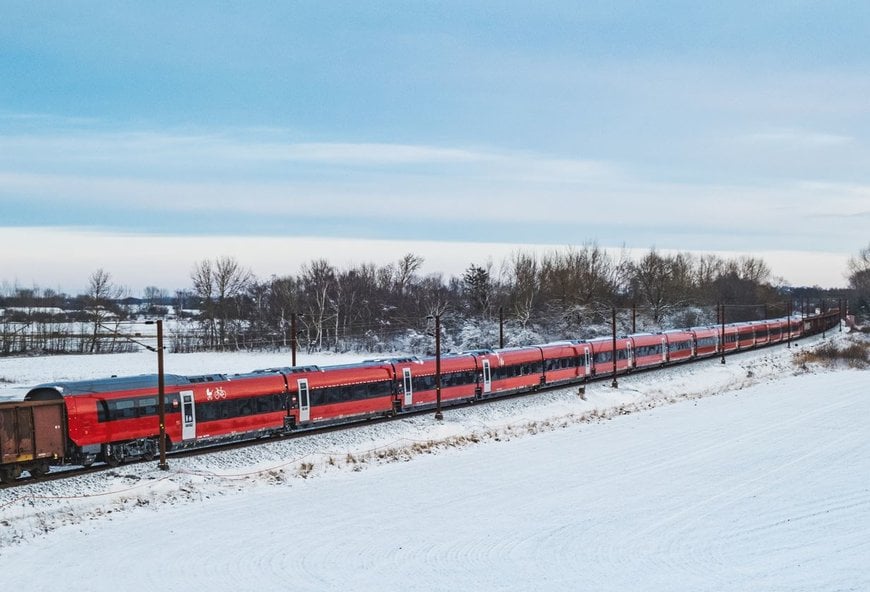railway-international.com
26
'24
Written on Modified on
DSB unveils Talgo Intercity trains to serve international routes
First unit of 16-train fleet reached Denmark on December 2023.

Danish State Railways company DSB today unveiled the first of the Talgo 230 units to enter its long-distance intercity train fleet in the following months. During a press event held in Copenhagen, the company announced the official kick-off of the dynamic testing phase of the trains which are expected to connect the Danish capital and Aarhus with Hamburg and potentially other international as well as domestic routes.
With a design speed of 230 km/h and an operating speed of 200 km/h, the trains will feature a larger width than standard cars in cross-border traffic, which will allow for more interior space and higher passenger comfort while keeping full technical interoperability to serve not only domestic routes but also international services.
As part of the Talgo 230 technological platform, the trains have also the capability to reduce energy consumption by up to 30% as compared with the industry standard thanks to the unique rolling assembly technology of the Spanish company and its lightweight passenger coaches, and boast a 95% recoverability of the train structure.
During the upcoming certification process all the systems will be validated to ensure the stringent levels of reliability DSB requires and to guarantee full technological compatibility of the train with the Danish infrastructure and with the existing, third-party locomotives.
In a second phase, a Talgo cab car (styrevogn; a passenger end-coach with a driving cab but no engines) will be added to each train to allow for a push-pull configuration that will ensure swift train turnaround times at the final destination of each route, while minimizing train weight and thus also cut accelerating and braking times.
This comes in addition to the operating flexibility the locomotive+coaches train formations already provide, and within a project implementation where total scope measured in coaches was increased by a 15% on the fly with almost no actual impact on the deployment.
One framework contract, three orders
Back in in February 2020 and after an open tendering process, DSB awarded Talgo with a framework contract worth €500 million which included a first firm order of €134 million for the supply of 8 complete trains of the Talgo 230 technological platform.
In April 2021 and in light of the new demand for international rail travel, DSB decided to increase the fleet size with a second order for additional coaches which raised the passenger capacity of the 8 initial trains by a full 10%, to 492 seats each. Then in April 2023 the railway company placed a third order, for 8 additional trains and worth €184 million.
About Talgo 230
The Talgo 230 platform is based on the same technological foundations that have established the Spanish train producer’s intercity trains as an international reference. They are light vehicles boasting independently rotating, self-guided rolling assemblies, able to maximize capacity and which can mount natural tilting and/or automatic track-gauge changing systems. They are also highly scalable: Acquired as conventional trains, they can be easily and inexpensively upgraded into true very high-speed trains for commercial top speeds of 300km/h – as Talgo is currently doing for the Spanish state-run company Renfe.
The Talgo 230 platform was also selected by the German federal operator Deutsche Bahn (DB) in 2019 with a framework agreement for the manufacture of up to 100 trains, with two blocks already ordered of 79 units in total of which the first ones are already under certification in Germany. DB is expected to use them both for domestic links and over the Berlin-Amsterdam route (Germany-Netherlands).
New Talgo DSB trains factsheet
Routes: International routes, at first Copenhagen-Hamburg and Aarhus-Hamburg
Maximum commercial speed: 200 km/h
Maximum design speed: 230 km/h
Passenger capacity: 492 seats
Coach types:
Flex-space coach: 36 seats; Prams; Bicycles; e-bikes recharging.
PRM coach: 3 PRM spaces; 1 PRM toilet; 10 conventional seats; Vending.
Second class coaches with 32 seats.
Second class coaches with 40 seats.
First class coach (2+1 seating) with 22 seats.
First class coach (2+1 seating) with 28 seats.
[Cab car (styrevogn): to be added in a later phase].
Recoverability of the train structure: 95%.
Rail in Denmark
Founded in 1885, DSB is one of the oldest state railway companies in Europe and it serves all the five regions of Denmark along a 2,600km-long rail network managed by independent state-owned infrastructure manager Banedanmark.
Denmark has one of the most intensively used rail systems in the European Union, with 722 passenger-km per capita (as compared to 348 passenger-km per capita of Spain), and rail is at the forefront of the country’s ambitious climate pledge, with plans to cut back carbon emissions by a 70% in 2030 (with the whole EU aiming for a 55%) and to become carbon neutral as soon as 2050. It is in under this strict commitment that DSB is investing heavily to enlarge and modernize its rolling stock fleet with new reliable and energy-efficient trains like the Talgo 230 unveiled today.
www.talgo.com

